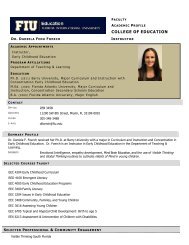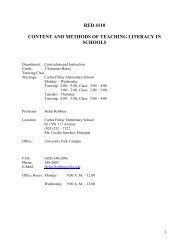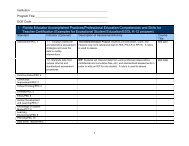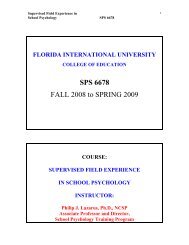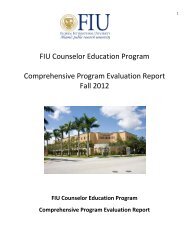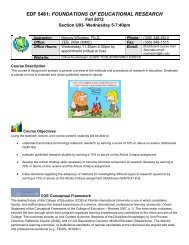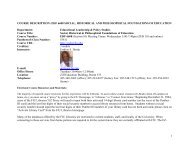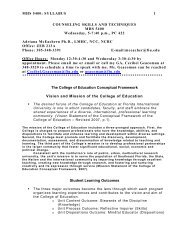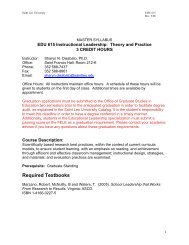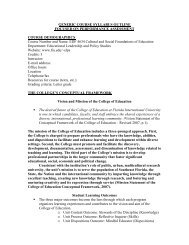2007 - College of Education - Florida International University
2007 - College of Education - Florida International University
2007 - College of Education - Florida International University
You also want an ePaper? Increase the reach of your titles
YUMPU automatically turns print PDFs into web optimized ePapers that Google loves.
scapulothoracic motion. The end <strong>of</strong> glenohumeral rotation occurs when a firm capsular end<br />
point is felt or when the scapula appreciates. 1<br />
A variety <strong>of</strong> measurement tools are available to determine ROM <strong>of</strong> the GH joint,<br />
including a mechanical and digital inclinometer, goniometer, and computerized tracking<br />
analysis. 1,2,6-8,10,12 Goniometric methods have displayed fair to good reliability 5 ; however, their<br />
applicability is limited in the clinical setting. Clinically, the examiner must efficiently be able to<br />
measure ROM without a second examiner present. Goniometric measurements <strong>of</strong>ten require two<br />
examiners; the first secures the goniometer and follows the movement <strong>of</strong> the forearm into<br />
rotation, while the second stabilizes the scapula. 5,8 Scapular stabilization, the application <strong>of</strong> a<br />
posterior force on the anterior coracoid and lateral clavicle to limit anterior tilt <strong>of</strong> the scapula,<br />
isolates glenohumeral rotation. 1,2-5,9,10<br />
A measuring instrument must be financially obtainable for clinical use. A computerized<br />
data tracking s<strong>of</strong>tware with joint position sensors can be used to determine ROM, but is not<br />
practical to a high school or small setting. Therefore, the purpose <strong>of</strong> this study was to establish a<br />
reliable measure <strong>of</strong> internal and external ROM using a mechanical inclinometer. We<br />
hypothesize our results will be similar to goniometric reliability <strong>of</strong> fair to good.<br />
Methods<br />
Participants were 10 healthy college-aged volunteers (20 shoulders) (9 right-hand<br />
dominant; 4 males, 6 females; age=23.2±2.4 y, mass=73±16 kg, height=170±8 cm) with no<br />
shoulder or neck injuries within the past year. Clinicians were two Certified Athletic Trainers<br />
(PD and PM) with novice experience using an inclinometer to assess ROM. Each clinician<br />
practiced with the mechanical inclinometer for one week prior to testing to gain familiarization<br />
with the instrument.<br />
Each clinician measured one subject at a time on two separate examination tables in an<br />
Athletic Training research laboratory. We measured maximal passive GH IR and ER bilaterally<br />
using an inexpensive mechanical inclinometer (Sears, Roebuck & Co., Chicago, IL). The<br />
inclinometer uses a pendulum to determine its angular relation to horizontal, accurate to 0.5°.<br />
We strapped the inclinometer firmly to each subject’s forearm at the distal radius using two 1”<br />
elastic straps with hook-and-loop closures. Each measurement followed standard procedures for<br />
assessing GH rotational ROM, with subjects lying supine on a standard treatment table with 90°<br />
<strong>of</strong> elbow flexion wearing a t-shirt or sports bra. This protocol for patient positioning is reported<br />
as a valid and reliable measure <strong>of</strong> isolated glenohumeral motion. 12 The clinician controlled<br />
scapular motion through visual inspection and patient positioning, with the scapula on the table.<br />
Clinicians considered maximal motion achieved when rotation ceased with a firm capsular endfeel<br />
and before they appreciated scapular motion. Clinicians then prompted a second<br />
investigator to record the angle indicated by the inclinometer. The two clinicians were blinded to<br />
each measure to remove bias. We measured each rotation twice, recording the average. We<br />
calculated GIRD as the difference between nondominant total arc and dominant total arc<br />
measures. Each clinician measured all 20 shoulders once to assess inter-examiner reliability and<br />
measured eight shoulders twice to assess intra-examiner reliability. Participants rested for 5<br />
minutes between measures to allow any affects <strong>of</strong> the measure to diminish before the next<br />
measurement. We used SPSS 14.0 (SPSS Inc., Chicago, IL) to calculate standard error <strong>of</strong><br />
measure (SEM) and evaluate intra- and inter-examiner reliability <strong>of</strong> dependent measures through<br />
ICC.



